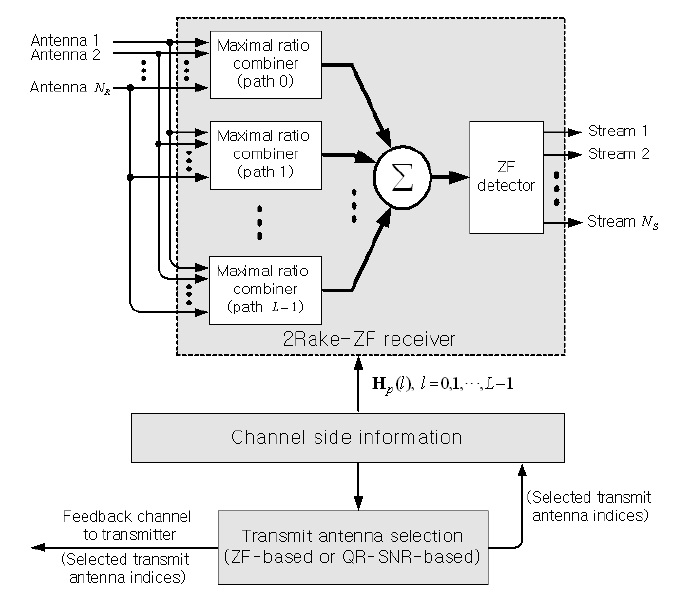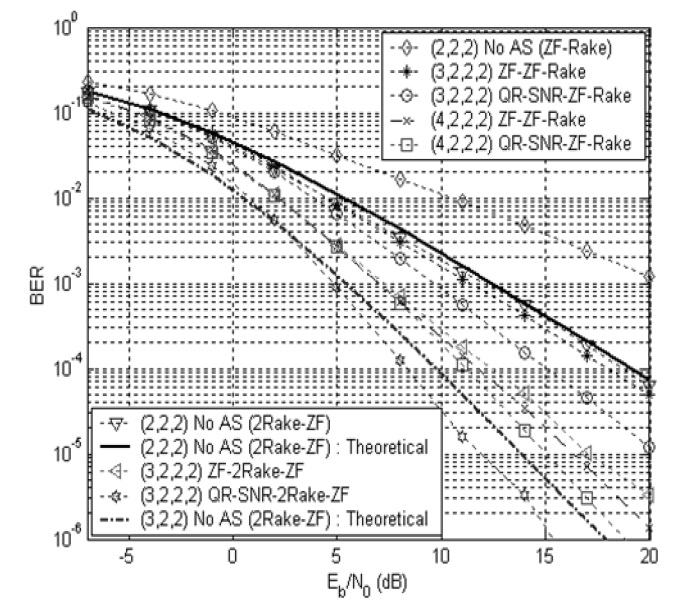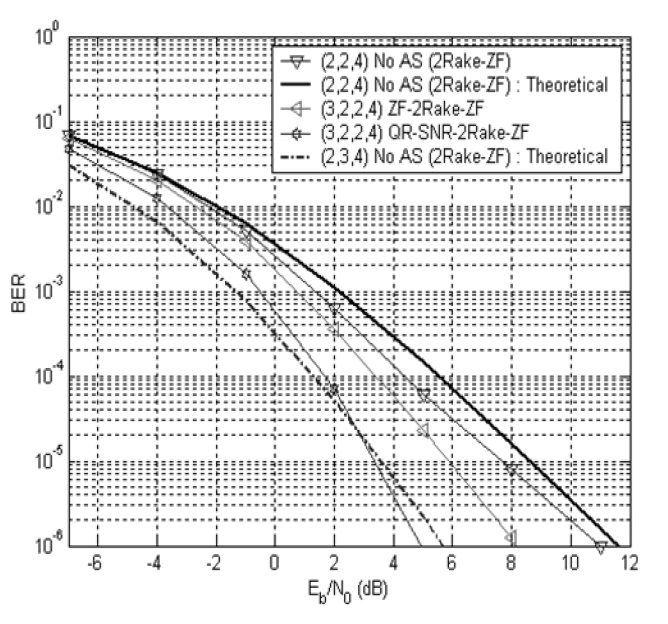



Ultra-wideband (UWB) radio technology has attracted tremendous interest for applications requiring high-data rate communications over short ranges. UWB systems trying for higher data rates and higher quality of communications can employ multiple input multiple output (MIMO) techniques [1]. However, the implementation of MIMO suffers the main disadvantage of increasing hardware costs due to the radio frequency (RF) chains and analog-to-digital converters needed. If we use an antenna selection technique, this handicap can be reduced [2-5]. In [6], the transmit antenna selection problem in spatial multiplexing (SM) UWB MIMO systems with zero-forcing (ZF) detectors followed by Rake combiners (called a ZF-Rake), whose structure has been analytically examined in [7], has been discussed. In [8], the 2-dimensional Rake architecture in the space and time domain followed by a ZF detector (called a 2Rake-ZF receiver) has been analytically examined to show that it can improve the error performance of the ZF-Rake receiver.
In this paper, a transmit antenna selection algorithm is applied to the spatial-temporal Rake combining-based SM UWB systems proposed in [8]. The transmit antenna selection criterion employed for selecting a subset of the transmit antennas is based on the largest minimum postprocessing signal-to-noise ratio (SNR) obtained on the basis of QR decomposition. Simulation results will show that the transmit antenna selection algorithm can significantly enhance the BER performance of SM UWB systems with the 2Rake-ZF receiver on a log-normal multipath fading channel. It will also be found that when the transmit antenna selection scheme is used in the SM UWB systems, the 2Rake-ZF receiver outperforms the ZF-Rake receiver and also achieves the diversity order of the full complexity antenna system.
II. SPATIAL-TEMPORAL COMBINING SYSTEMS USING TRANSMIT ANTENNA SELECTION
To examine the antenna diversity gain through transmit antenna selection, the spatial-temporal combining-based SM UWB systems presented in [8] with
subsets of transmit antennas is carried out by a transmit antenna selection algorithm on the receiver. The receiver feeds back to the transmitter the determined subset. The input data to the multiplexer are serial-to-parallel converted into
After the received signal at each receive antenna goes through a correlator, the resulting correlator outputs are spatially and temporally combined by the 2-dimensional Rake receiver over each bit interval, as shown in Fig. 1. Then the discrete-time spatial signal vector, u =
, is written as [8],
where
with the information bit from the nth data stream denoted by
where
After the outputs of the spatial-temporal 2-dimensional Rake combiners are performed by a ZF detector,
to spatially decorrelate
where (□)† denotes the pseudoinverse and
Note that this work focuses on using ZF detection even if other SM MIMO detection techniques could be considered.
III. TRANSMIT ANTENNA SELECTION FOR SPATIAL-TEMPORAL COMBINING SYSTEMS
From expression (5), the SNR of the ZF detector output signal on the
In order to derive the post-processing SNR expression in the 2Rake-ZF receiver, the channel matrix,
obtained after spatial-temporal combining is considered instead of using only H
determined by the transmit antenna selection process can be factorized by QR decomposition
with unitary
and the upper triangular
. The left side of the
Then the received signal vector is modified to
The postdetection SNR of layer
where
is the
. The elements of
can be calculated by the well-known QR factorization algorithm based on a modified Gram-Schmidt method.
An antenna subset selection is determined by the maximum minimum post-detection SNR. It searches for a transmit antenna subset with the maximum value among
and
, respectively, which are defined as minimums of
, and
,
and
values. Finally, the 2Rake-ZF receiver is operated for signal detection using the determined antenna subset. Thus the 2Rake-ZF receivers based on ZF-SC and QRSNR- SC are called ZF-2Rake-ZF and QR-SNR-2Rake-ZF, respectively.
Even if the communication system with antenna selection considered in [2] and [4] is not a SM UWB one with a lognormal fading distribution, the antenna selection has been shown to maintain the same diversity advantage as the full complexity antenna system without antenna selection. To observe the antenna diversity gain of the ZF-2Rake-ZF and QR-SNR-2Rake-ZF through antenna selection, this work considers the average BER performance of the 2Rake-ZF UWB system with no antenna selection in a log-normal fading channel examined in [8], which is given by
where,
Here,
The average power of the path with index
(independent of
where
Fig. 2 shows the BER performance as a function of
(2,2,2) 2Rake-ZF receiver with no antenna selection. It is also found that the 2Rake-ZF receiver with antenna selection has much better performance than the ZF-Rake receiver. It is observed that the (3,2,2,2) 2Rake-ZF antenna diversity system outperforms the (4,2,2,2) ZFRake antenna diversity system. It is seen that the QR-SNRSC provides much better performance than the ZF-SC. The BER performance of the (3,2,2,4) 2Rake-ZF system with
Using expression (9), theoretical BER results of the 2Rake-ZF systems are also plotted in Figs. 2 and 3. It is shown that the (2,3,2) and (2,3,4) 2Rake-ZF MIMO systems can be regarded as full complexity antenna systems without antenna selection of the (3,2,2,2) and (3,2,2,4) 2Rake-ZF antenna selection systems, respectively. The ZF- 2Rake-ZF has almost the same asymptotic slope as the full system, which means that it can provide the same diversity gain as the full system. Meanwhile, the QR-SNR-2Rake-ZF has a slightly larger slope than the full antenna system, which implies that it offers an additional SNR gain. Thus it is confirmed that the antenna selection achieves the diversity order of the full system.
The BER performance of a SM UWB system with transmit antenna selection has been evaluated over indoor log-normal fading channels. The employed receiver consists of maximal ratio combiners and multipath combiners that capture


